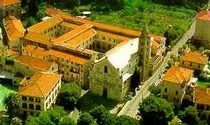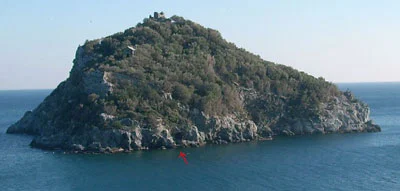bergeggi
Documents
The islet of Bergeggi
The stretch of coast between Bergeggi and Spotorno has a very varied morphology; it alternates beaches and short promontories with sheer cliffs, where the sea has dug small caves. Opposite, not far from the mainland, stands the small island of Bergeggi, a suggestive cone of limestone rock that reaches 53 meters above sea level.
a suggestive cone of limestone rock that reaches 53 meters above sea level.
 a suggestive cone of limestone rock that reaches 53 meters above sea level.
a suggestive cone of limestone rock that reaches 53 meters above sea level.It seems that in ancient times the island was connected to the coast by a narrow rocky tongue, then demolished by the wave motion. Today it is rocky and steep, covered only in part by Mediterranean vegetation. This island preserves remarkable historical and archaeological evidence. On its top there are remains of military and religious buildings, dating back to different eras. The oldest buildings were most likely erected in late Roman times.

At the highest point of the island are preserved the bases of a massive cylindrical construction, perhaps a watchtower or a lighthouse erected in function of the nearby port of Vada Sabatia (the current Vado Ligure). In the Middle Ages the islet of Bergeggi, similarly to the other small Ligurian islands, was the seat for a long time of Monastic communities. This is testified by the modest ruins of a small early Christian church of the V-VI century and the most conspicuous of a Romanesque building with two naves of the eleventh century. This last building attracts our attention because it is St. Eugene.
EUGENIO, saint, venerated in NOLI.
Local Ligurian tradition believes that Eugene was one of the African bishops exiled at the end of the century. V. during the vandal persecution. Held for some time in Corsica. Eugene would have landed in Liguria in the area of Vado and Savona, would have preached the Gospel in the region and, dead, would have been buried in the small island of Liguria, today known as Bergeggi.
The first historical document that recalls this Eugene is a diploma with which the emperor Otto III, at the request of the bishop of Savona (Bernardo), in 998 confirmed his assets to the Savona Church, including: "ecclesiam sancti Eugenii ubi eius corpus humatum (inhumed) recquiescit ".(the church of St. Eugene, where his buried body (inhumed) rests.)
Here the same bishop Bernardo erected a monastery which he entrusted to the Benedictines of Lerinesi (Isle of Lèrins in front of Cannes - FR). which remained on the island until around 1232.
After the monks left, the building fell into disrepair and Eugene's body was moved to nearby Noli, first in the church of S. Paragono and, in 1602, in the Cathedral.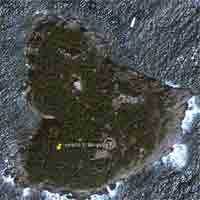

Eugene was venerated as the patron saint of the tiny Maritime Republic of Noli and his feast, celebrated on the second Sunday of July, is characterized by great folkloristic events.
It is not possible to say precisely who this Eugene actually was. Popular belief and the liturgy of the diocese of Noli identified him with the eponymous bishop of Carthage; but this claim was already fought by an anonymous writer of the century. XII. who claimed that Eugene was a monk. Probably, therefore, it is an obscure Eugene of Bergeggi later confused with the bishop of Carthage.
Bibliotheca Sanctorum, John XXIII Institute, Pontifical Lateran University, 1961. Vol. 5 (1964), p. 194.
A copy of this work, which has already been updated to 16 vol., Is in our Monastery.
Historical notes also gleaned from the writings of the Benedictine historian P. Gregorio Penco
The Vandals conquer North Africa in the first half of the 5th century. (429-440).
According to a tradition, Eugene, Vindemiale and Fiorenzo, African bishops, were exiled (in 484) to Corsica by the vandal king Unirico, who was of the Aryan religion.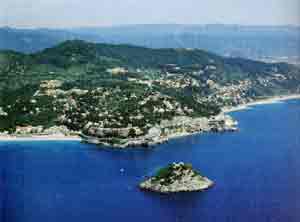

Fiorenzo dies on the island, the others reached the Savona area. Here Eugene dedicated himself to the evangelization of the inhabitants of the mainland opposite the island and of the Vado area.
Eugene died on the island of Bergeggi in 505, where he was buried.
The small island, just 3ha of surface and reaches 53 m. above sea level, it had a fresh water vein.
For this reason it was inhabited by man at least since the Neolithic, as evidenced by excavations carried out.
Until the last century there was still a well of drinking water.It was buried because the water no longer complied with current hygiene standards.
This well was located near the small pier with a concrete ladder, which can be seen from the opposite promontory of Punta Maiolo (Torre del Mare).
With the decline of the Western Roman Empire and under the influence of the Byzantine Empire, an oriental type of hermit monastic life flourished on the islands of Liguria (such as in San Lorenzo di Varigotti).
An indication of the Byzantine influence can still be found in the Finale area in the devotion to St. Anthony the Abbot, father of Eastern monasticism, (see the Chapel of St. Anthony the Abbot, in Monte, above Finalpia).
In the West the Benedictine Rule was established in the sec. VIII-IX.
Before, there were various types of mixed rules: Abbey of S. Onorato (Lérins, France), Abbey of S. Martino di Tours (Gallinara, Italy), Abbey of S. Colombano (Bobbio).
THE ABBEY OF SAN EUGENIO
On that island, in 998, thanks to the bishop of Savona Bernardo, the Abbey of S. Eugenio was built (V. Riv. Stor. Bened., V. - 1910).
For this foundation, Bernard relied on the experienced monks of the famous Monastery of Lèrins, existing since the beginning of the 5th century (400/410), on an island opposite Cannes, in southern France.
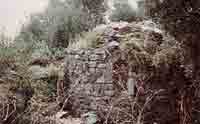 The new Monastery of the Bergeggi had a good development: coming to have a church (albeit small) with two naves.
The new Monastery of the Bergeggi had a good development: coming to have a church (albeit small) with two naves.The land assets of the Abbey were initially the land with a wine vocation and olive groves and were mainly located between the coastal areas of Spotorno and Vado.
Over time the Abbey was enriched with possessions even beyond the Ligurian dewlap.
The ruins of the first early Christian church and the complex of the church and monastery of Sant'Augenio are still visible today.
Among its dependent churches there was also Altare (SV).
This village was part of a fiefdom that, since the 10th century, Lèrins had entrusted to the monks of the Monastery of 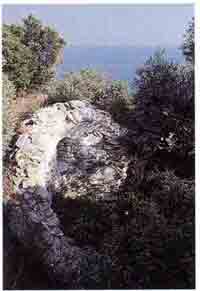 Sant'Eugenio.
Sant'Eugenio.
 Sant'Eugenio.
Sant'Eugenio.Thanks to the monks of the Abbey of the island of Bergeggi, the new village with the ancient parish church of Sant'Eugenio (today the Church of the Santissima Annunziata) was founded in Altare in the twelfth century.
The same monks then became the "importers" from France of the activity linked to the production and processing of glass, an art that in the following centuries will make Altare's economic fortune.
On 13/03/1162 Alexander III, the pope of the Lombard League, exiled to France by Barbarossa, landed on the island: his election had taken place against the will of the emperor Frederick Barbarossa.
It was the Saturday preceding Palm Sunday and his entourage (that of an exile ...) consisted of only 2 cardinals.
Due to a storm, which prevented him from resuming his journey, he celebrated Easter there with the monks of the monastery who, surprised and amazed, had welcomed him with immense joy.
However, the stay for more than a week of the Pope and his - albeit limited - following, involved so considerable expenses, that it took a few years to be honored with creditors.
Alexander III, born Rolando Bandinelli (Siena, around 1100 - Civita Castellana, 30 August 1181), had been elected pope of the Catholic Church in 1159, and was therefore not even sixty years old.
It was in his honor that in 1168 the city of Alexandria was founded, near the confluence of the Bormida river with the Tanaro river.
Alexander allied himself with the Municipalities, fighting against Frederick Barbarossa, because he aimed at a 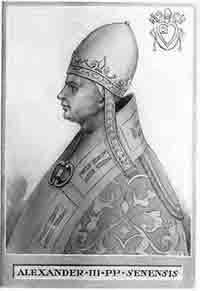 policy of intervention and dominance over the Church as well.
policy of intervention and dominance over the Church as well.
 policy of intervention and dominance over the Church as well.
policy of intervention and dominance over the Church as well.The imperial current appointed various and successive antipopes in vain.
The battle of Legnano (1176) marked the definitive defeat of the German emperor.
With the Peace of Venice of 1177 Federico was reconciled with the pope, even if only temporarily.
Let's take a leap forward almost a century, to move towards a bitter conclusion ...
In 1239 Noli was detached from the diocese of Savona (Ghibelline, i.e. imperial) and was erected as a suffragan diocese of Genoa (Guelph, i.e. papal) and was united aeque et principaliter(equally and principally) to the Abbey-Diocese of Brugnato, in the province of La  Spezia.
Spezia.
 Spezia.
Spezia.Meanwhile, the times of the conflict between the empire of Frederick II and the papacy had already been started
In 1245 Pope Innocent IV, to make the new diocese of Noli independent of Brugnato, assigned the latter the properties of the Bergeggi monastery.
The bishop of Noli thus also became abbot of the Abbey of S. Eugenio, depriving the abbot in office.
Monastic bodies became involved in diocesan structures according to political needs.
The abbey, deprived of its possessions, survived amidst difficulties and discord for another hundred years, while the monastic structures on the islet were heading towards an increasingly serious deterioration.
The monastery was suppressed and together with the island were incorporated into the territories of the Republic of Noli and the Diocese of Noli. The remains of Saint Eugene then came definitively transferred to Noli. Every year, on July 12, on the occasion of the feast of Sant'Eugenio, a procession of boats leaves from Noli and lands on the island carrying the remains of the saint.
of the saint.
 of the saint.
of the saint.Today, on the islet of Bergeggi, we only see more of its ruins, despite the presence of a gate with a function more of a deterrent than an effective safeguard.
